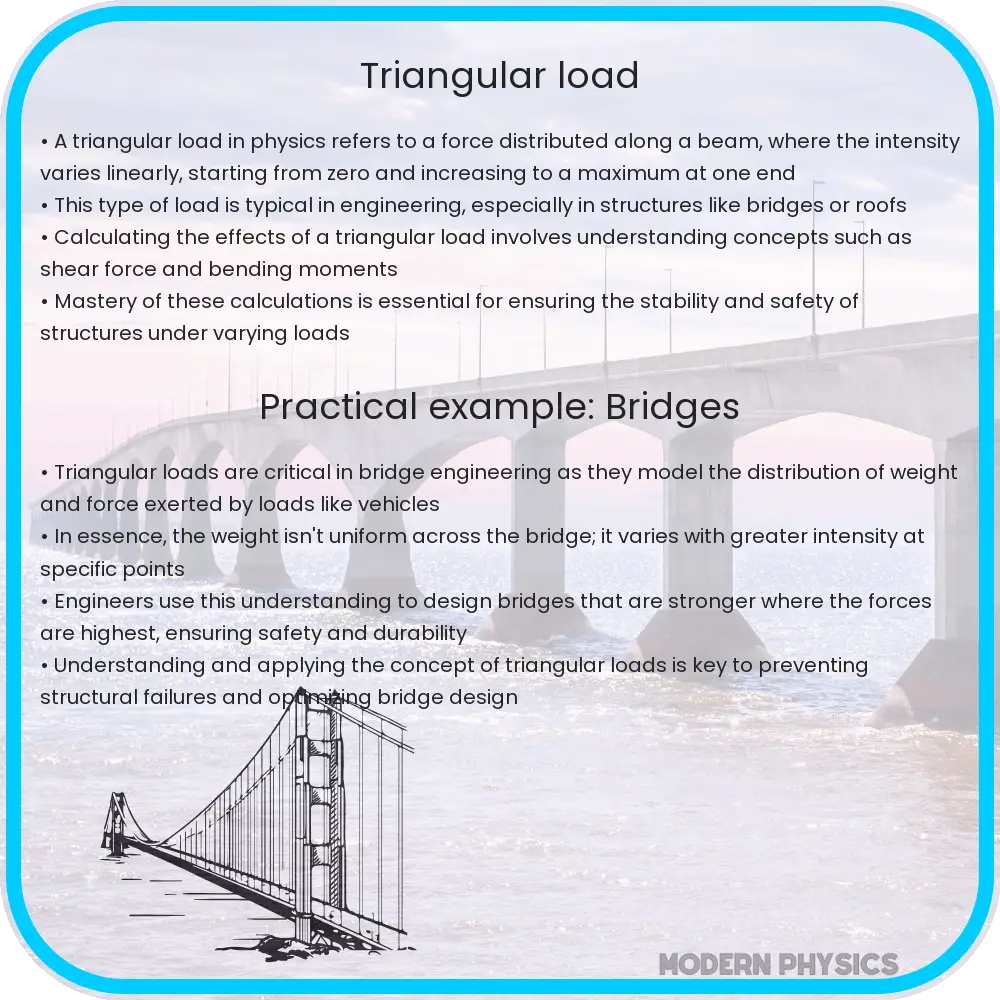Explore the fundamentals of triangular load distribution in engineering, including analysis, statics, and practical applications for structures.

Understanding Triangular Load Distribution in Engineering
Triangular load distribution is a fundamental concept in the field of engineering, particularly in the analysis of structures. This type of load distribution is commonly encountered in various engineering applications, including bridges, beams, and building structures. It is characterized by a load that varies linearly along a support, typically reaching a maximum at one point and tapering to zero at another.
Basics of Triangular Load Distribution
In the simplest terms, a triangular load distribution can be visualized as a triangular shape, where the load intensity varies along the length of the structure. The highest intensity is at the peak of the triangle, and it decreases linearly to zero at the base. This distribution is often used to represent real-life load conditions, such as unevenly distributed weights on beams or pressure distributions in fluid mechanics.
Analysis Under Triangular Load
When analyzing structures under a triangular load, engineers use principles of statics and mechanics of materials. The goal is to determine the reactions at supports, shear forces, bending moments, and deflections of the structure. This analysis is crucial for ensuring the safety and integrity of the structure under load.
- Calculation of Reactions: The first step in the analysis is to calculate the reactions at the supports. This involves resolving the triangular load into a resultant force and applying equilibrium conditions.
- Shear Force and Bending Moment Diagrams: Shear force and bending moment diagrams are graphical representations that show how these forces vary along the length of the beam. For a triangular load, these diagrams typically exhibit non-linear variations.
- Deflection Analysis: Understanding how a beam deflects under a triangular load is crucial. This involves using the bending equation, \( M/I = \sigma /y = E/R \), where \( M \) is the bending moment, \( I \) is the moment of inertia, \( \sigma \) is the stress, \( y \) is the distance from the neutral axis, \( E \) is the modulus of elasticity, and \( R \) is the radius of curvature.
The analysis of structures under triangular load distribution is a complex process that requires a deep understanding of statics and material properties. Accurate calculations are essential for the safe design and construction of various engineering structures.
Statics in Triangular Load Distribution
The principles of statics play a critical role in analyzing structures subjected to triangular loads. Statics, the branch of mechanics dealing with bodies at rest, provides the framework for understanding the equilibrium of forces in these structures. In the context of triangular load distribution, the analysis ensures that the sum of all forces and moments acting on a structure is zero, indicating a state of equilibrium.
Practical Applications and Considerations
Triangular load distribution is not just a theoretical concept but has practical implications in engineering design. For instance, in bridge construction, load distribution can resemble a triangular pattern due to the varying weight of vehicles and their positions. Similarly, in roof trusses, snow loads often create a triangular distribution. Understanding this concept allows engineers to design structures that can withstand such varying load conditions efficiently and safely.
However, it’s crucial to consider factors like material properties, geometry of the structure, and environmental conditions. These factors can significantly influence the response of a structure under a triangular load. Engineers must also account for potential dynamic loads and the long-term effects of stress and fatigue on materials.
Advanced Techniques in Analysis
With advancements in technology, engineers now employ sophisticated tools and software for structural analysis under triangular loads. These tools use numerical methods, such as finite element analysis (FEA), to provide more accurate and detailed insights into the stress distribution and potential points of failure in a structure. Such analyses are invaluable in designing safer and more efficient structures.
Conclusion
Triangular load distribution is a pivotal concept in structural engineering, providing insights into how loads are distributed and borne by various structures. From the basic principles of statics to the complex calculations of shear forces and bending moments, understanding triangular load distribution is essential for the safe and efficient design of engineering structures. As technology advances, the precision in analyzing and designing structures under such loads continues to improve, leading to safer, more reliable, and cost-effective engineering solutions. The continuous evolution of analytical methods and tools further enhances our ability to predict and manage the effects of these loads, ensuring the longevity and integrity of structures in various engineering fields.
